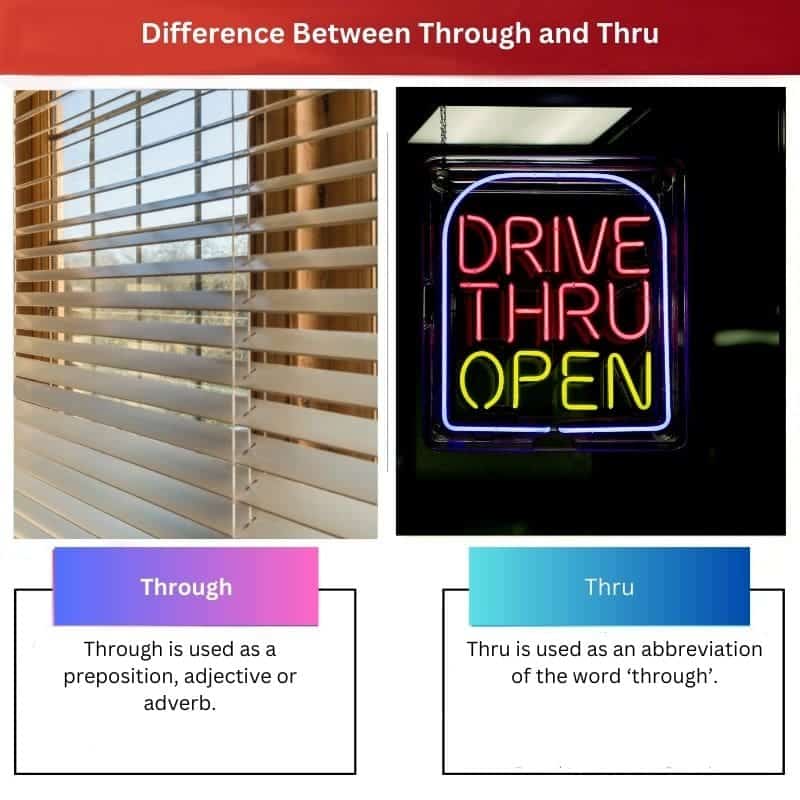Whereas ‘thru’ is a non-standardised version of the word ’through’. That is, it is an alternatively spelt word that means the same as’through’.
Language changes constantly. The changes are nuanced, circumstantial and situational.
A considerable difference can be noticed in the way people text and directly speak to their friends, family, acquaintances and superior officers. One can easily spot the way in which the speech is altered to suit the needs of the situation and the people involved in it.
The words through and thru are examples that also show this contrast.
Key Takeaways
- “Through” is the standard spelling for the preposition and adverb, indicating movement in one side and out the other or completion of a process.
- “Thru” is an informal, colloquial spelling of “through,” used in casual writing or specific contexts like drive-thru services.
- Both “through” and “thru” convey the same meaning, but “through” is preferred in formal writing and professional contexts.
Through vs Thru
Through is an English word which acts as a preposition, adjective and adverb on various occasions. Through means movement from one thing to another, from one side to another, etc. Thru is a non-formal way of writing ‘Through’. It is seen in texts and other informal writing pieces.

Comparison Table
| Parameter of Comparison | Through | Thru |
|---|---|---|
| Usage | Through is used as a preposition, adjective or adverb. | Thru is used as an abbreviation of the word ‘through’. |
| Situation | Through is used in formal situations. | Thru is used in informal situations. |
| Acceptability | Through is acceptable in all contexts. | Thru is acceptable in informal writing. |
| Standard | Through is seen as the standard way of using its meaning. | Thru is not the standard way of using the word and its meaning. |
| Contextual Example | E.g., through the driveway. | E.g., drive-thru. |
What is Through?
The word ‘Through’ means movement from one thing to another, from one side to another, etc.
For example, when you say, “I am going through a tunnel”, it means you are moving from one end of a tunnel to another end; that is, you are moving through the tunnel.
This word can also mean continuing with something till its end.
For example, when you say, “She has to get through this level to win the badge, ” that person should go through the entire level and complete it to win the badge.
The word ‘Through’ is also used instead of the phrase “by means of”.
For example, in the sentence, “The company bagged the new deal through promotion and marketing”, the word ‘Through’ is used as an alternative to the phrase “by means of”.
In this context, ‘Through’ means that the company landed on the deal by means of or with the help of promotion and marketing.
This word is also used in several other contexts, such as when you are being connected to another person over the phone or when your relationship with someone has ended.
Here are a few examples to clarify its usage: –
- “Sure, ma’am. Let me put you through to the administrator’s office”.
- “Not one more word from your mouth! I am through with you. Our deal has come to an end”.
The word is also used as a part of the phrase” through and through, ” meaning completely or thoroughly.
Examples: –
- “He is their supporter through and through”.
- ‘Through’ performs the functions of a preposition, adjective and adverb, depending upon the subject of the sentence, its structure and the requirements of the situation.
- ‘Through’ is seen as the standard spelling of the word. It is used in all types of situations, articles and sentences.

What is Thru?
As the introduction mentions, two words can have different spellings by meaning the same.
When and even, your and you’re, you and u are pairs of words that mean the same but have different spellings. The latter is an abbreviated version of the former in all these pairs of words.
Similarly, ‘Thru’ is an abbreviation of the word ‘Through’.
It is a non-formal way of writing ‘Through’. This word is seen in text messages and other informal writing pieces.
This word is frequently seen on signs at restaurants and even on traffic signals such as ‘no-thru’ signals.‘Thru’ is a non-standard way of writing ‘Through’ and is not accepted in academic and professional writings.
Although there is nothing wrong in texting your friend, “How am I going to get thru the entire syllabus?”; using the word ‘Thru’ in a formal setting or communication thread is seen to be inappropriate.
Thru is an abbreviation of ‘Through’, like message and msg and ‘and’ and ‘nd’.

Main Differences Between Through and Thru
- The main difference between the words ‘through’ and ‘thru’ is that the former is the appropriate word used. But the latter is an abbreviation of the word ‘through’.
- The word ‘Through’ is used in formal writings and communication. The word ‘thru’ is seen in informal communication and messages.
- ‘Through’ is the accepted way of using the word. But ‘thru’ is not accepted in academic writings, professional articles, and journals.
- ‘Through’ is seen as the standard way of its usage. But ‘thru’ is the non-standard way of its usage.
- While ‘through’ is used as a preposition, adjective and adverb in sentences, ‘thru’ is used in text messages instead of ‘through’ or phrases such as ‘drive-thru’ and ‘no-thru-signals’.

- https://www.tandfonline.com/doi/pdf/10.1080/00947679.1979.12066922
- https://heinonline.org/hol-cgi-bin/get_pdf.cgi

I find the inclusion of the spelling ‘thru’ quite ironic given the intellectual tone of the post.
I can understand your perspective Cameron. It does seem contradictory in a way.
This post makes me think about the broader implications of language changes. It’s quite thought-provoking.
I completely agree Amy. Language is a reflection of society and culture, and it’s fascinating to study.
I appreciate the comprehensive discussion of the word ‘through’. It’s a word we take for granted.
You’re absolutely right Millie. It’s eye-opening to dive deep into seemingly simple words.
The comparison table is particularly effective in highlighting the key differences. Great structure to the post.
The visual representation definitely adds value to the post.
I agree with you Mike, the table format makes it easy to comprehend the distinctions.
The contextual examples provided really helped grasp the usage of ‘through’ and ‘thru’. Very well written.
Absolutely, it’s always helpful to have clear examples to understand the distinctions.
The humorous examples towards the end made the post more engaging. Well done!
I respectfully disagree. They seemed out of place to me, but it’s subjective.
I felt the same way John. It was a pleasant surprise to have those lighthearted examples.
Very informative and well-explained post. It’s interesting to see how language is constantly evolving and changing. I appreciate the detailed comparison between ‘through’ and ‘thru’.
I had never thought about some of these differences before. Thanks for the great explanation.
I completely agree Natasha, it’s fascinating to analyze these nuances in language.
I disagree with the acceptance of ‘thru’ in informal writing. Language should be upheld to the same standards regardless of formality.
I see your point Patrick, but language does naturally evolve over time. It’s interesting to observe these changes.
I have mixed feelings about this, but the post is well-researched and I appreciate the insights.
Overall, a very well-presented and thorough exploration of language nuances. Kudos to the writer.
Definitely, a commendable effort in dissecting the intricacies of language. Enjoyed reading this.
I find the use of ‘thru’ quite irritating. It’s important to maintain proper spelling and grammar in professional contexts. Great post though.
I never thought about it that way. Interesting perspective.
I understand where you’re coming from Bailey. It can be frustrating to see these informal spellings in serious settings.